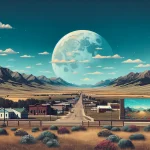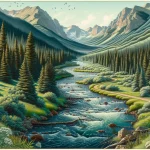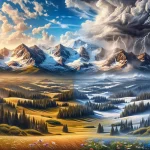The East Fork Navajo River, located in southwestern Colorado, is a hidden gem that offers a wealth of outdoor recreation opportunities. From world-class trout fishing to breathtaking hiking trails, this area is a paradise for nature enthusiasts.
In This Article
TL;DR
- East Fork Navajo River is a premier destination for fly fishing, with abundant trout populations in its pristine waters.
- The surrounding San Juan National Forest boasts scenic hiking trails, camping sites, and opportunities for wildlife viewing and nature photography.
- Visitors can engage in eco-tourism activities and contribute to conservation efforts in the area.
Destination Overview
Located in southern Colorado near Pagosa Springs, the East Fork of the Navajo River is a key tributary of the Navajo River, which spans across Colorado and New Mexico. Originating in the San Juan Mountains, this river flows southward before merging with the main channel of the Navajo River.
The East Fork Navajo River winds through the picturesque San Juan National Forest, providing a serene and unspoiled setting for outdoor adventures. The river’s crystal-clear waters are renowned for their exceptional trout fishing, attracting anglers from around the world. Beyond the river, the surrounding forest offers a diverse array of activities, from hiking and backpacking to kayaking and river rafting.
River Fishing and Outdoor Recreation
Fly fishing enthusiasts will find their paradise along the East Fork Navajo River. The river’s cold, oxygenated waters are home to thriving populations of rainbow, brown, and cutthroat trout. Experienced guides are available to share their expertise and lead visitors to the best fishing spots. For those seeking a more adrenaline-fueled experience, the river also offers opportunities for kayaking and river rafting, with varying levels of difficulty to suit all skill levels.
Hiking and Backpacking Trails
The San Juan National Forest surrounding the East Fork Navajo River is a hiker’s dream. From easy nature trails to challenging multi-day backpacking routes, there is something for everyone. The East Fork Trail, a popular option, follows the river’s course and offers stunning views of the surrounding peaks. For those seeking a more strenuous adventure, the Weminuche Wilderness, located within the national forest, boasts rugged terrain and breathtaking vistas.
Wildlife Viewing and Nature Photography
With its diverse ecosystems and abundant wildlife, the East Fork Navajo River and the surrounding areas offer unparalleled opportunities for nature enthusiasts. Keep your eyes peeled for elk, mule deer, black bears, and a variety of bird species, including the majestic bald eagle. Photographers will be captivated by the stunning landscapes, from towering peaks to cascading waterfalls, providing endless opportunities to capture nature’s beauty.
Eco-Tourism and Conservation
East Fork Navajo River and the San Juan National Forest are home to several conservation areas and initiatives aimed at preserving the region’s natural resources. Visitors can participate in eco-tourism activities, such as guided nature walks and educational programs, to learn about the local flora and fauna while minimizing their environmental impact. By supporting these efforts, tourists can contribute to the long-term protection of this remarkable destination.
Camping and Accommodations
For those seeking an immersive outdoor experience, East Fork Navajo River offers several well-equipped camping sites settled in the heart of the national forest. These sites provide access to hiking trails, fishing spots, and stunning natural surroundings. Alternatively, eco-friendly lodges and cabins in nearby towns like Pagosa Springs offer a comfortable retreat after a day of outdoor adventures.
Access and Navigation
East Fork Navajo River is easily accessible from several points along the San Juan National Forest’s network of Forest Service roads. Visitors can reach the river and its surrounding attractions by following well-marked trails and access points. For those exploring the broader region, the towns of Pagosa Springs and Durango serve as convenient gateways, offering amenities and services for travelers.
FAQ
What is the best time of year for trout fishing on the East Fork Navajo River?
The prime season for trout fishing on East Fork Navajo River is from late spring through early fall, with the peak months being July and August. However, experienced anglers can find success year-round, as the river’s cold waters sustain healthy trout populations.
Are permits required for hiking or camping in the San Juan National Forest?
While no permits are required for day hiking, overnight camping in the San Juan National Forest requires a permit, which can be obtained from the local Forest Service office or online. Certain areas, such as the Weminuche Wilderness, may have additional regulations.
What safety precautions should be taken when participating in outdoor activities in the area?
When engaging in outdoor activities around East Fork Navajo River, it’s essential to be prepared for changing weather conditions, carry appropriate gear, and follow safety guidelines. Hikers should always carry a map, compass, and adequate supplies. River enthusiasts should wear life jackets and follow local regulations.
Are there any guided tours or educational programs available in the area?
Yes, several local outfitters and organizations offer guided tours and educational programs focused on various aspects of the area, including fly fishing, hiking, wildlife viewing, and nature photography. These guided experiences can enhance your understanding and appreciation of the region’s natural wonders.
How can visitors contribute to conservation efforts in the area?
Visitors can support conservation efforts by practicing Leave No Trace principles, respecting wildlife and their habitats, and participating in eco-tourism activities that support local conservation organizations. Additionally, visitors can volunteer for trail maintenance or participate in organized clean-up events in the area.






